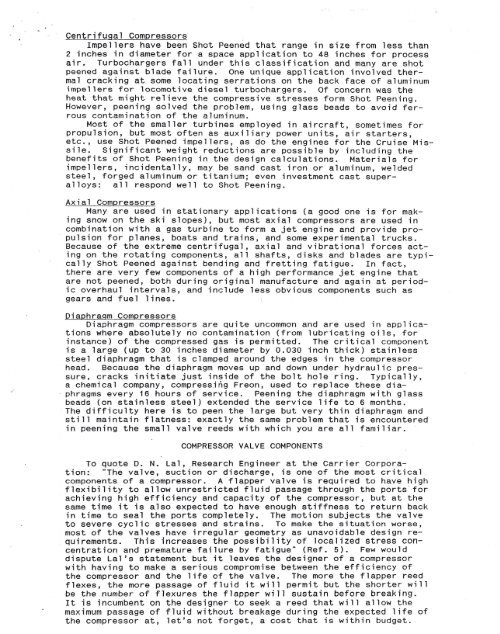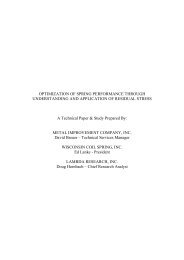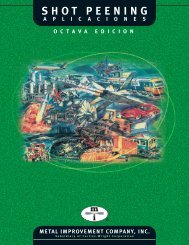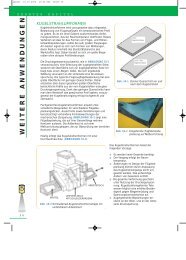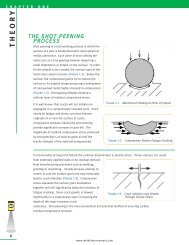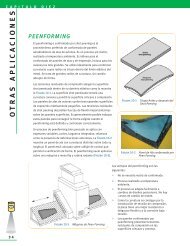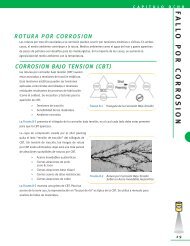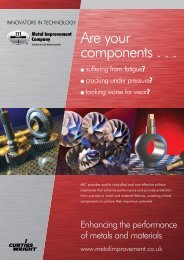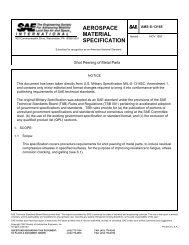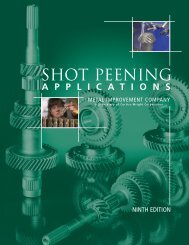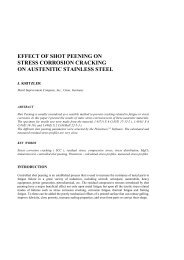Stress-lite Shot Peening of Compressor Reed Valve Components
Stress-lite Shot Peening of Compressor Reed Valve Components
Stress-lite Shot Peening of Compressor Reed Valve Components
You also want an ePaper? Increase the reach of your titles
YUMPU automatically turns print PDFs into web optimized ePapers that Google loves.
Centrifugal <strong>Compressor</strong>s<br />
Impellers have been <strong>Shot</strong> Peened that range in size from less than<br />
2 inches in diameter for a space application to 48 inches for process<br />
air. Turbochargers fall under this classification and many are shot<br />
peened against blade failure. One unique application involved thermal<br />
cracking at some locating serrations on the back face <strong>of</strong> aluminum<br />
impellers for locomotive diesel turbochargers. Of concern was the<br />
heat that might relieve the compressive stresses form <strong>Shot</strong> <strong>Peening</strong>.<br />
However, peening solved the problem, using glass beads to avoid ferrous<br />
contamination <strong>of</strong> the aluminum.<br />
Most <strong>of</strong> the smaller turbines employed in aircraft, sometimes for<br />
propulsion, but most <strong>of</strong>ten as auxiliary power units, air starters,<br />
etc., use <strong>Shot</strong> Peened impellers, as do the engines for the Cruise Missile.<br />
Significant weight reductions are possible by including the<br />
benefits <strong>of</strong> <strong>Shot</strong> <strong>Peening</strong> in the design calculations. Materials for<br />
impellers, incidentally, may be sand cast iron or aluminum, welded<br />
steel, forged aluminum or titanium; even investment cast superalloys:<br />
all respond well to <strong>Shot</strong> <strong>Peening</strong>.<br />
Axial <strong>Compressor</strong>s<br />
Many are used in stationary applications (a good one is for making<br />
snow on the ski slopes), but most axial compressors are used in<br />
combination with a gas turbine to form a jet engine and provide propulsion<br />
for planes, boats and trains, and some experimental trucks.<br />
Because <strong>of</strong> the extreme centrifugal, axial and vibrational forces acting<br />
on the rotating components, all shafts, disks and blades are typically<br />
<strong>Shot</strong> Peened against bending and fretting fatigue. In fact,<br />
there are very few components <strong>of</strong> a high performance jet engine that<br />
are not peened, both during original manufacture and again at periodic<br />
overhaul intervals, and include less obvious components such as<br />
gears and fuel lines.<br />
Diaphragm <strong>Compressor</strong>s<br />
Diaphragm compressors are quite uncommon and are used in applications<br />
where absolutely no contamination (from lubricating oils, for<br />
instance) <strong>of</strong> the compressed gas is permitted. The critical component<br />
is a large (up to 30 inches diameter by 0.030 inch thick) stainless<br />
steel diaphragm that is clamped around the edges in the compressor<br />
head. Because the diaphragm moves up and down under hydraulic pressure,<br />
cracks initiate just inside <strong>of</strong> the bolt hole ring. Typically,<br />
a chemical company, compressj~g Freon, used to replace these diaphragms<br />
every 16 hours <strong>of</strong> service. <strong>Peening</strong> the diaphragm with glass<br />
beads (on stainless steel) extended the service life to 6 months.<br />
The difficulty here is to peen the large but very thin diaphragm and<br />
still maintain flatness: exactly the same problem that is encountered<br />
in peening the small valve reeds with which you are all familiar.<br />
COMPRESSOR VALVE COMPONENTS<br />
To Quote D. N. Lal, Research Engineer at the Carrier Corporation:<br />
"The valve, suction or discharge, is one <strong>of</strong> the most critical<br />
components <strong>of</strong> a compressor. A flapper valve is required to have high<br />
flexibility to allow unrestricted fluid passage through the ports-for<br />
achieving high efficiency and capacity <strong>of</strong> the compressor, but at the<br />
same time it is also expected to have enough stiffness to return back<br />
in time to seal the ports completely. The motion subjects the valve<br />
to severe cyclic stresses and strains. To make the situation worse,<br />
most <strong>of</strong> the valves have irregular geometry as unavoidable design re-<br />
Quirements. This increases the possibility <strong>of</strong> localized stress concentration<br />
and premature failure by fatigue" (Ref. 5). Few would<br />
dispute Lal's statement but it leaves the designer <strong>of</strong> a compressor<br />
with having to make a serious compromise between the efficiency <strong>of</strong><br />
the compressor and the life <strong>of</strong> the valve. The more the flapper reed<br />
flexes, the more passage <strong>of</strong> fluid it will permit but the shorter will<br />
be the number <strong>of</strong> flexures the flapper will sustain before breaking.<br />
It is incumbent on the designer to seek a reed that will allow the<br />
maximum passage <strong>of</strong> fluid without breakage during the expected life <strong>of</strong><br />
the compressor at, let's not forget, a cost that is within budget.


